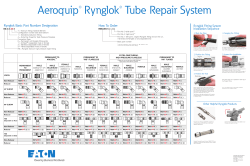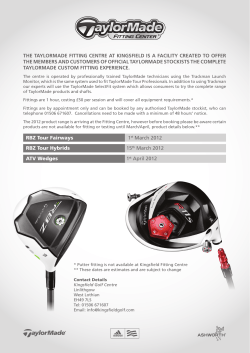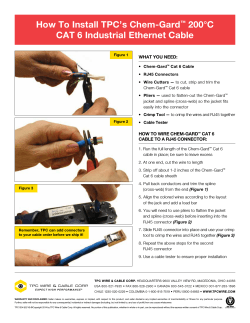
Complete Solutions in Emergency Lighting STANILITE TESTING PRECAUTIONS
Complete Solutions in Emergency Lighting STANILITE Complete Solutions in Emergency Lighting STANILITE Doc No: 29-00024 TESTING PRECAUTIONS Once the fitting is permanently connected to the mains supply, a commissioning discharge test as required in AS/NZS2293.2 must be carried out. You will need to allow 24 hours for the battery to fully charge prior to conducting this test, presently (at the time of writing), the standard requires that fittings operate in emergency mode for a period not less than 2 hours for their commissioning test and for not less than 90 minutes thereafter (it is required that 6 monthly discharge tests be carried out). You will need to keep the records for the commissioning test and enter them into the building emergency services logbook or via other recording methods as allowed by AS/NZ2293.2. CONSTRUCTION SITES Continuously switching of the mains power supply that is connected to emergency light fittings during the construction phase of an installation will cause these fittings to discharge and charge their batteries many times over a short period; this can shorten the life of the battery and will also result in shortened emergency lamp life for fluorescent fittings. Thomas & Betts does not recommend such practices and may not honour the warranty on batteries when they are subjected to such harsh operating conditions. Emergency light fittings are designed to be discharge tested once every 6 months as per AS/NZS2293.2, subjecting the product to repeated discharge or charge cycles is regarded as an abuse of the fittings. TROUBLE SHOOTING GUIDE If you have installed and connected the unit as per the instructions listed earlier and it does not function correctly, use the following table as a guide to fixing the problem. Look up the type of fault in the left column and check the possible causes from the right column. # Fault Possible Causes 1 LED tube/s and indicating LED not lit AC supply not connected; or AC supply turned off 2 LED tube/s is lit but indicating LED not lit Test switch damaged; or Battery not connected or faulty 3 Emergency LED light source does not switch to emergency mode when the test button is pressed Test switch damaged; or Battery not connected or faulty 4 Emergency LED light source works momentarily on emergency when the test button is pressed Battery not yet charged (allow up to 24 hours) Thomas & Betts (Australasia) Pty. Ltd. ABN: 062 074 810 898 Head Office: Unit D3, 3-29 Birnie Avenue, Lidcombe NSW 2141, Australia Manufacturing: 23a Nyrang Street, Lidcombe NSW 2141, Australia Phone: 1300 666 595 Fax: 1300 666 594 Email: austsales@tnb.com Website: www.tnbaust.com LED Batten 2x9W with Motion Detect Sensor Installation Manual Standard, Nexus LX, Nexus RF This Document Covers What’s Inside the box Safety Warning LED Batten Installation Instructions Installation Manual Removal Instructions Warranty Information Testing Precautions Trouble Shooting Guide GREETINGS Congratulations on choosing to use this Thomas & Betts product covered by our unique Through-Life Support system. This document is designed to assist you during the installation of this product; for the safety of yourself and others Thomas & Betts recommends that you read this document thoroughly before commencing installation. The fittings are designed for easy installation. They are advanced pieces of electronic equipment which, when treated with care and maintained through regular and appropriate servicing, will perform reliably for many years to come. If the unit still does not work after checking these possible causes, contact Thomas & Betts Service in Australia on 1300 666 595, Monday to Friday, 8.30am to 4.30pm (AEST) and ask for help. Our trained service personnel will usually be able to take your call immediately and assist you in resolving your difficulty. Thomas & Betts is committed to providing valuable Through-Life Support for its products. SAFETY WARNING In Australia and New Zealand, only licensed electricians are permitted by law to work with 240 Volt electrical installations. Do not attempt to install or connect this product unless you are a licensed electrician. Turn off and isolate the electrical supply before connecting this fitting to the building wires. Do not touch the terminals of the terminal block when the light fitting is energised. The only user-serviceable parts are fluorescent or halogen lamp/s. LED light sources are not user-servicable. Do not tamper with the fitting or the warranty will be void. As the installer, it is your responsibility to ensure compliance with all relevant building and safety codes, (ie: AS3000, AS/NZS2293). Refer to the applicable standards for data and mains cabling installation procedures and requirements. Important Note: This product is designed for indoor use only. NEXUS LX (DATA CABLE SYSTEM) The Nexus range of emergency light fitting are designed to be connected together into a special communication network over a Level 4 (or higher) high speed, single twisted pair data cable. The Nexus LX User & Technical Guide describes all you need to know to successfully install a Nexus project. Ask for it from your supervisor, from your employer or from your nearest Thomas & Betts product supplier. The network cabling of the building must be installed as per the procedure detailed in the Nexus LX User & Technical Guide. No mains or mains carrying cables are to be connected to the data terminals or cables. NEXUS RF (WIRELESS SYSTEM) The Nexus RF range of light fittings are designed to communicate via a proprietary RF network, however the electrical installation of the fittings is identical to that of a standard non-monitored fitting. © Thomas & Betts (Australasia) Pty. Ltd. 2014 Rev: 1.0 4 August 2014 4 © Thomas & Betts (Australasia) Pty. Ltd. 2014 Rev: 1.0 4 August 2014 1 Complete Solutions in Emergency Lighting STANILITE Complete Solutions in Emergency Lighting INSTALLATION INSTRUCTIONS 1. Remove the unit from the packing box and inspect it for damage or imperfections. If any damage is found, do not install the unit, but replace it carefully into the packing box and notify the Thomas & Betts Product Support Hotline in Australia on 1300 666 595. 2. If all looks okay, installation can proceed. 3. Remove the end cap and wire guard as shown in figure 1. 4. Remove the LED tubes and cover as show in figure 2. 5. Determine the mounting location and cable entry direction, put the batten against the ceiling and mark the position of the mounting screw holes. For side cable entry, remove the cable entry knockout. Note: The fitting is designed for ceiling mounted applications. If wall mounting is required then the angle bracket kit PRB209WMBKT (sold separately) must be used. 6. Route the mains cable through the cable entry hole. The cable needs to be mechanically protected with a grommet, gland or bush as it passes though the cable entry hole. 8. Strip 9mm insulation length from mains cable, connect and terminate wires to the terminal block. Be careful with multi-strand conductors that all the strands are twisted together before insertion into the terminal. Any stray strands that inadvertently come into contact with their neighbouring terminal will cause undesirable results when the fitting is powered. Wire/Fitting Type Maintained - with SA Switched active Wire to SA terminal Unswitched active Wire to terminal A Neutral Wire to terminal N Earth Wire to terminal E or STANILITE Fitting Type/Fitting State Normal Operation Test Switch Pressed (after 5 minutes charging) Maintained - with SA Lamp/s will operate on a dimmed level on stand-by (no motion detected). Lamps will illuminate to full brightness when motion is detected within the area covered by the lamp motion detector. Emergency LED at the end of the luminaire will illuminate. Fitting Type LED State - on initial powering - no fitting faults Non-monitored Solid red Nexus LX Flashing green Nexus RF Green flash with 2 red blinks, green flash with 3 red blinks 12. Re-install the wire guard and end cap. DATA CONNECTIONS - NEXUS LX & NEXUS RF PRODUCT RANGE Secure the batten to the ceiling using appropriate fixings (not supplied) depending on the type of building construction material used. 7. 9. Figure 1 Figure 2 Antenna Cover edges facing up Sensors Figure 3 Cable Verify that the battery is connected to the power pack. For Nexus LX product; connect the data cable to the power pack PCA. For Nexus RF product; fit the antenna connector to the hole provided in the base and then install the antenna. For more details refer to the Data Connections section. Nexus LX fitting: Connect the data cable to the green connector on the power pack. When correctly installed no fitting should have more than 2 data cables connected to it. If you have more than 2 data cables at any 1 fitting, the installation is incorrect. If this fitting is at the end of a data cable run, a terminator needs to wire in parallel across the 2 data lines. If there is an in and out data cable, then the shields should be wound together, folded back and taped up. Consult the Nexus LX User & Technical Guide for further detail, including product commissioning. Nexus RF fitting: Fit the antenna connector through the vacant hole on the gear tray and connect the antenna to it as shown. Collect the MAC address, by removing the peel off sticker section and locating it on your floor plan or spreadsheet Note: Other end of the antenna has been pre-connected to the power pack. Consult the Nexus RF User & Technical Guide for further detail, including product commissioning. Important Note: 24 hours is required to allow the fitting battery to reach full capacity, ie: prior to a discharge test. As the installer, it is your responsibility to conduct the initial discharge testing of the installed fitting. Refer to AS/NZS2293. 10. Refit the cover to the base with the edges facing up as shown in figure 2, fit the LED tubes with the sensor on the opposite ends to achieve uniform motion sensing range, see figure 3. REMOVAL INSTRUCTIONS 11. Check the operation of the fitting to ensure a successful installation. When powered up, allow a few minutes to give the battery a small charge then press the test button to ensure the unit is functional in emergency mode. 2. 3. 4. 5. 6. 1. Before removing the installed fitting, de-energise and lock off the supply circuit. Note: There may be 2 actives present, ensure all power is isolated before proceeding. Remove the end cap and wire guard as shown in figure 1. Remove the LED tubes and cover as shown in figure 2. Disconnect the mains cable from the terminal block. Disconnect the battery plug from the battery. Unscrew the mounting screws and remove the fitting. Note: When the fitting is reconnected to the supply, it will need time to recharge its battery for 24 hours before it will be capable of a full length discharge again. © Thomas & Betts (Australasia) Pty. Ltd. 2014 Rev: 1.0 4 August 2014 2 © Thomas & Betts (Australasia) Pty. Ltd. 2014 Rev: 1.0 4 August 2014 3
© Copyright 2025












